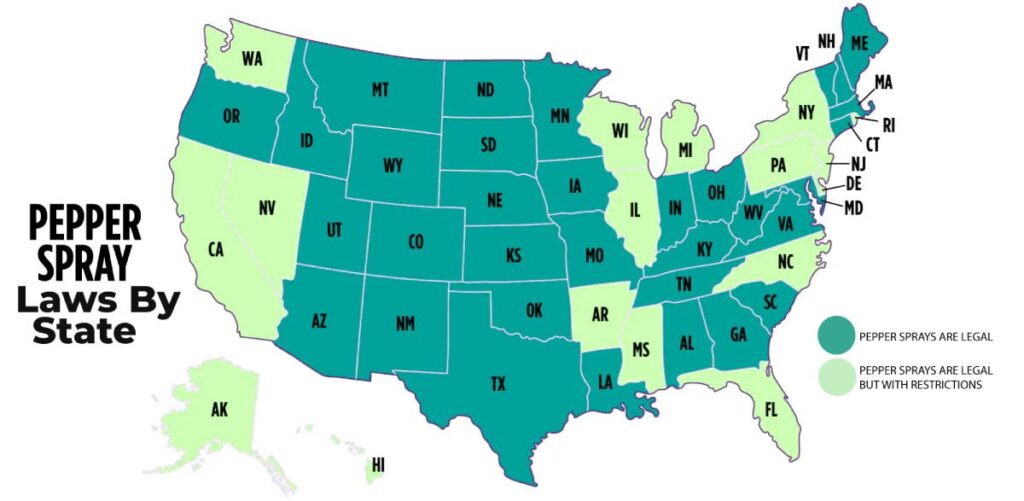Table of Contents
- Connecticut Pepper Spray Regulations Overview and Key Legal Definitions
- Understanding OC Concentration Limits and How They Affect Self-Defense Choices
- Permitted Container Sizes and Restrictions on Pepper Spray Purchase and Possession
- Best Practices for Safe Usage and Compliance with Connecticut Pepper Spray Laws
- Concluding Remarks
Connecticut Pepper Spray Regulations Overview and Key Legal Definitions
In Connecticut, the legality of pepper spray is governed by specific regulations that aim to balance personal safety with public protection. Individuals aged 18 and older are allowed to carry pepper spray, but the product must adhere to strict guidelines regarding its composition and size. The law defines pepper spray as a “defensive spray” primarily intended for protection against human attacks, prohibiting use against animals or for any illegal purposes. It’s critical to understand that Connecticut limits the amount of oleoresin capsicum (OC) in pepper spray products to ensure safety without compromising effectiveness.
Key legal definitions include:
- Oleoresin Capsicum (OC): The active ingredient responsible for the spray’s irritant effect, restricted to a certain percentage by state law.
- Size restrictions: Pepper spray containers must not exceed a specific volume, ensuring they remain non-lethal and manageable for everyday carry.
- Authorized use: Pepper spray is designated strictly for self-defense, with misuse potentially resulting in legal penalties.
Understanding OC Concentration Limits and How They Affect Self-Defense Choices
When selecting a pepper spray for personal protection in Connecticut, understanding the limits on Oleoresin Capsicum (OC) concentration is crucial. The state regulates the potency to ensure the spray is effective yet within legal safety boundaries. Typically, sprays with an OC concentration exceeding 10% are prohibited, as higher percentages could lead to severe injury rather than self-defense. This restriction directly influences which products are legally available and encourages users to seek sprays that balance potency with lawful compliance. Choosing a spray within these limits ensures you can protect yourself without risking legal repercussions.
Beyond the chemical strength, the size of the spray canister also affects your self-defense choice. Connecticut law commonly limits the container capacity to 2.5 ounces or less, which impacts how long you can deploy the spray during an emergency. When deciding on the right pepper spray, consider these factors:
- Legal compliance: Stick to approved OC concentration and size restrictions.
- Ease of carry: Smaller cans are pocket-friendly but might offer fewer bursts.
- Effectiveness: Look for sprays with a balanced formula that maximizes defense within allowed limits.
Permitted Container Sizes and Restrictions on Pepper Spray Purchase and Possession
In Connecticut, the law strictly regulates the size of pepper spray containers individuals may legally purchase and carry. The maximum allowable size is limited to 2.5 ounces (70 grams), ensuring that users carry a manageable and safe amount of OC spray. This limitation is intended to prevent excessive use and promote responsible self-defense practices. Larger containers, often marketed for law enforcement, are prohibited for civilian use, and possessing these can lead to legal consequences.
Additionally, the state places specific restrictions on who may purchase pepper spray. Buyers must be at least 18 years old and are typically required to provide identification at the point of sale. Notably, individuals with certain criminal convictions or protective orders against them may be barred from purchasing or possessing any pepper spray products. Retailers are often vigilant in enforcing these prerequisites, and it’s essential for consumers to be aware of not just size restrictions but also eligibility rules to stay fully compliant with Connecticut’s pepper spray legislation.
Best Practices for Safe Usage and Compliance with Connecticut Pepper Spray Laws
To ensure you stay within the boundaries of Connecticut’s pepper spray regulations, always purchase OC sprays that comply with the state-mandated size limits-typically containers holding less than 2.5 ounces. Avoid carrying large or non-labeled units, as these can lead to legal complications. When using pepper spray, aim only at an attacker’s face to maximize effectiveness and minimize unintended harm. Keep your spray accessible but concealed, and be mindful of your surrounding environment to prevent accidental exposure to bystanders or pets.
- Register your pepper spray if required by local laws.
- Store it safely away from children and unauthorized users.
- Regularly check expiration dates to maintain effectiveness.
- Understand how to deploy your spray confidently through practice with inert training models.
Additionally, familiarize yourself with situations where pepper spray use is legally justified to avoid inadvertent misuse. Connecticut law permits pepper spray solely for self-defense, so employing it in any form of aggression could result in prosecution. Staying informed about legislative changes and consulting with legal professionals if in doubt can provide peace of mind and ensure your right to protect yourself remains intact.
Concluding Remarks
In summary, understanding Connecticut’s pepper spray laws is essential for responsible and legal self-defense. By familiarizing yourself with the state’s limits on OC concentration, allowable container sizes, and usage regulations, you can ensure you’re prepared while staying within the law. Always remember to purchase pepper spray from reputable sources and use it strictly in situations that warrant self-protection. Staying informed empowers you to protect yourself confidently and responsibly in Connecticut.Check Our Other Blogs
- StunGun – Your Trusted Source for Stun Guns, Laws, and Self-Defense Tips
- PepperSprayLaws – Your Trusted Resource for Pepper Spray Information
- StunGunLaws – Your Trusted Guide to Stun Gun Legality and Safety




